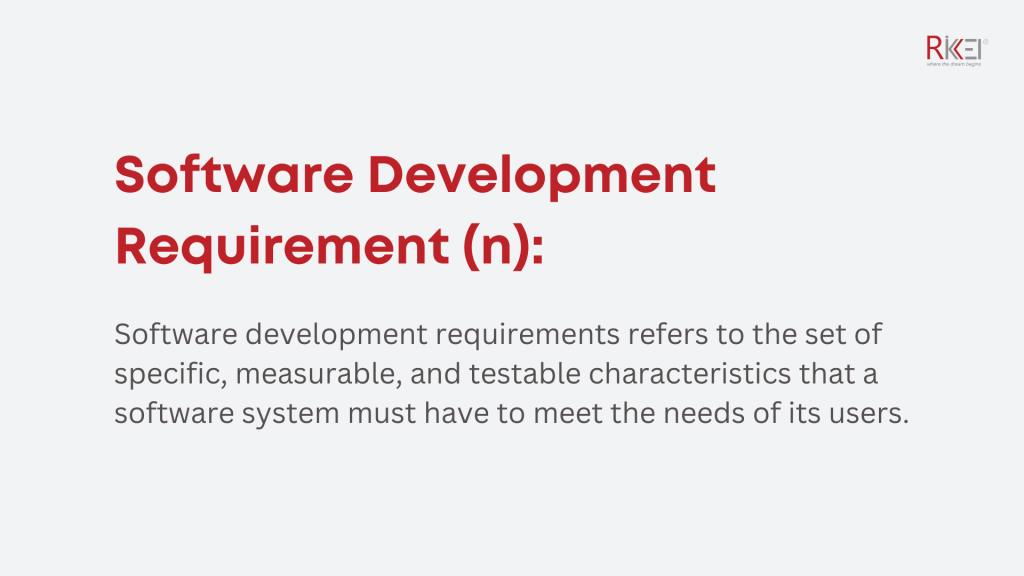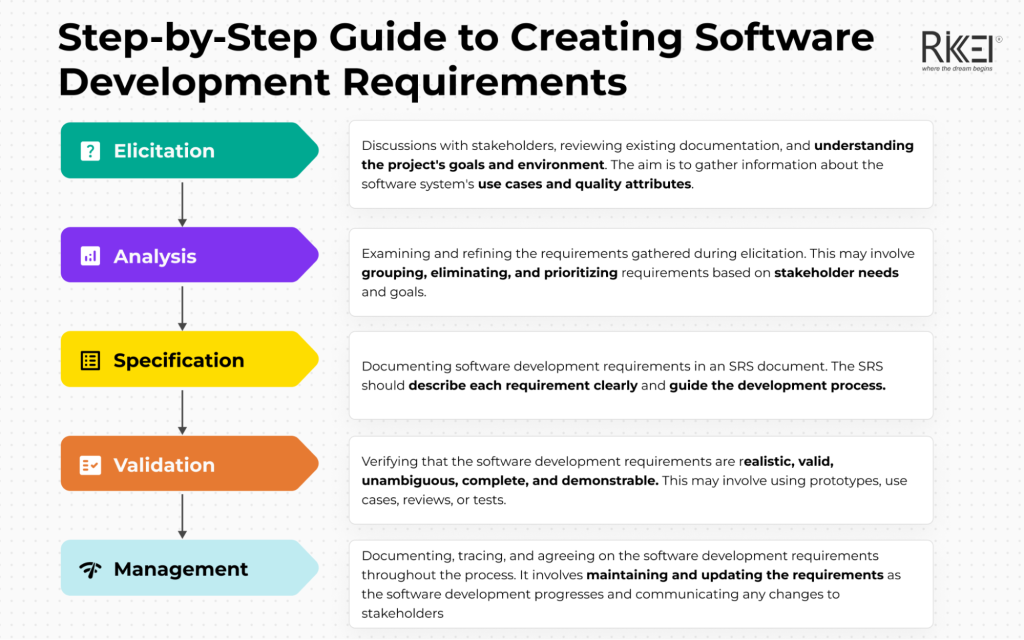Complete Guide to Software Development Requirements
Contents
As anyone would have guessed, software development is vital to building software systems. It is where the entire software system is born out of. To ensure that software systems meet the needs of their users, software engineers must have a thorough understanding of software requirements. This blog post will define these requirements, discuss their different types, and provide a step-by-step guide to creating software development requirements.
Definition of Software Development Requirements

Software development requirements refers to the set of specific, measurable, and testable characteristics that a software system must have to meet the needs of its users. As defined by the IEEE Standard Glossary of Software Engineering Terminology (source: https://standards.ieee.org/ieee/729/967/), a requirement is:
- A condition or capability needed by a user to solve a problem or achieve an objective.
- A condition or capability that must be met or possessed by a system or system component to satisfy a contract, standard, specification, or other formally imposed document.
- A documented representation of a condition or capability as in 1 or 2.
Requirements serve as the foundation for software development and provide the basis for defining and verifying the software’s functionality. Requirements also provide a roadmap for software development, guiding the development process and ensuring that the software system meets its intended purpose. It also serves as a reference point in communication for stakeholders – customers, end-users, and software developers.
By clearly defining the requirements for software development, stakeholders can ensure they have a common understanding of what the software system should do and how it should perform. This is important because it helps to reduce the risk of misunderstandings, which can lead to delays, cost overruns, and dissatisfaction with the final product.
What Are the Types of Software Development Requirements?
Software development requirements are typically categorized into two types: functional requirements and non-functional requirements.

Functional Requirements
Functional requirements describe what a software system and its component should do. These requirements specify the functionalities the software must provide alongside each function’s inputs and expected outputs. For example, a functional requirement for an e-commerce website might state that the website must allow users to view and purchase products.
Functional requirements can involve calculations, data manipulation, data processing, as well as other specific functionalities that define what the software should accomplish. Plans for implementing functional requirements are detailed in the system design.
Functional requirements are often expressed in use cases, describing how a user interacts with the software system. For example, a use case for an e-commerce website might describe the user’s steps to view and purchase a product. By expressing functional requirements as use cases, software engineers can ensure they clearly understand how end users will use the software system.
Non-functional Requirements
Non-functional requirements describe how well the software system should perform rather than its specific behaviors. These requirements specify the quality attributes of the software system, such as performance, security, usability, and reliability. For example, a non-functional requirement for an e-commerce website might state that the website must be available 99.9% of the time.
As functional requirements define what the software should do, non-functional requirements define what it should be. Rather than specific use cases, non-functional requirements dictate a system’s overall property, marking the difference between success or failure in development.
Non-functional requirements are expressed in terms of constraints or performance criteria for the software system. For example, a performance requirement for an e-commerce website might specify the maximum response time for a user to view and purchase a product. By expressing non-functional requirements regarding constraints and performance criteria, software engineers can ensure that the software system meets the desired quality attributes.
Step-by-Step Guide to Creating Software Development Requirements
While developing software requirements, one must go through five steps – elicitation, analysis, specification, validation, and management. This section will walk you through them, with definitions and standard practices when performing these tasks.

Elicitation
The first step to creating software requirements is requirement elicitation. While sometimes called “requirement gathering”, the term “elicitation” stresses that good requirements cannot be simply acquired from the customers and users by asking them what the software should and should not do. Requirements can come from many different sources, namely:
- Stakeholders (clients, end-users, developers)
- Business goals
- Operational environment
What you would want to do during the elicitation stage is to have thorough discussions with stakeholders, such as customers, end-users, and subject matter experts through interviews, questionnaires, brainstorming sessions, user observation, and more. For example, a first meeting between software developers and clients is desirable at this stage of the project. It is important that you manage different stakeholders’ viewpoints well, as their requirements for software development can overlap or clash with each other.
Elicitation may also involve the review of existing requirements documentation and identifying new requirements based on changes in the environment or technology. It is also recommended to pay extra attention to the project’s goals for requirements, as well as the operational environment of the client company. Your requirements should not be introducing major changes to preexisting systems, if at all.
The overall goal of the elicitation step is to gather information about the software system, including the goals and objectives of the stakeholders, the use cases that the software system will support, and the quality attributes the software system must possess. This information is used to create a comprehensive list of requirements that will guide the further development of the software system.
Analysis
The analysis involves examining and refining the requirements for software development gathered during the elicitation step. This may involve grouping similar requirements, eliminating redundant or conflicting requirements, and prioritizing requirements based on their importance to the stakeholders.
During analysis, it is vital that you identify each and every stakeholder involved in the project. By correctly identifying those involved in the project, it will be much easier to define and prioritize software development requirements.
To streamline the software development process, requirements are analyzed and categorized into groups sharing the same end goal. This helps developers have a better understanding and overview of the product so that they can do their best to satisfy the requirements. Listed below are some of the most common categories for software development requirements.
| Category | Definition |
| Business Requirements | These software development requirements have the least to do with actual development. They exist as statements of business goals and are mostly high-level capabilities needed to achieve a desired business outcome. |
| Customer Requirements | Customer requirements define customers’ expectations regarding the usage of the software product. These requirements should answer the following questions: Where will the product be used?How will the product accomplish its objectives?What can be used to measure its performance?How are its components going to be used?How efficient is the product?How long will the product be used? |
| Architectural Requirements | Architectural requirements highlight system architecture features that must be incorporated within the software project. |
| Performance Requirements | Performance requirements measure how well the software product runs and perform its tasks. |
Analysis ensures the requirements for software development are clear, complete, and consistent. This can be done by creating measurable goals: treating software development requirements as clues to discover the project’s true purpose and continuously asking “Why should we do this?” to create a list of thoroughly defined goals. This is important because well-defined goals are necessary to guide the development process and to ensure that the software system meets the needs of its users.
Specification
After gathering and analyzing the requirements for software development, you will need to write them down. The specification step involves the documentation of the software development requirements. This document, often aptly referred to as the Software Requirement Specification (SRS), strives to thoroughly detail the software in development in a series of its musts and needs.
SRS is a required part of any development project. A realistic estimation of the software project’s scale, cost, risks, and schedules is defined within an SRS. It is not an exaggeration to say that the success of a software project lies in a well-defined and -organized SRS document.
The SRS should be written by someone with a deep knowledge of the system, preferably a technical writer, a software programmer, or a systems architect working closely with the project. It should clearly and concisely describe each requirement and any applicable constraints or performance criteria. The specification should include additional information necessary to understand the requirements, such as diagrams, flow charts, or prototypes.
The goal of the specification step is to provide a clear and complete description of the software development requirements, which can be used to guide the development process and to ensure that the software system meets the needs of its end users.
Validation
After creating the SRS, it is time to validate the requirements for software development. The validation step involves verifying that the requirements:
- Can be realistically implemented into the project
- Are valid. They should not be illegal or impractical to the project.
- Are ambiguous. No one should be able to misinterpret the meanings of the requirements.
- Are complete.
- Can be demonstrated.
This may involve using prototypes, performing use cases, reviewing the requirements documentation, or conducting. The goal of the validation step is to ensure that the software engineering requirements accurately reflect the needs of the stakeholders and that the software system will meet its intended purpose.
Management
Software development requirements management is documenting, tracing, and agreeing on the requirements necessary for the software project. Rather than a separate step in the requirement creation pipeline, it is performed throughout the process, ensuring the needs of the project’s stakeholders are met.
Requirements management involves maintaining and updating the software engineering requirements as the software development progresses. This may involve adding new requirements, modifying existing requirements, or removing no longer relevant ones. It also requires communication between stakeholders so that any changes to requirements are known by everyone involved, reducing the risks of misunderstanding associated with changes and alterations.
Requirements should also be made traceable – anyone should be able to track each requirement’s origins and any changes done to it. Requirements management establishes and maintains this traceability for as long as the software development process lasts.
It is noteworthy that management does not stop after release. Continuously observing and adding new requirements post-release is also important to requirements management so that the software project can be the most successful.
Rikkeisoft – Your Trustworthy Technology Service Provider
If creating software requirements proves too cumbersome for your liking, you can always outsource your software development to a third-party service provider like Rikkeisoft.
Founded in 2012, RIkkeisoft is a leading software development firm based in Vietnam. We assist businesses with building powerful and effective software systems and products, with over ten years of software development experience in various industries. Our primary clientele is international, and we strive to provide the best quality IT services for small businesses.
With our expertise, common practices in software development, like creating detailed and thorough requirements for software development, are daily occurrences, and you can trust us to deliver our best regarding these issues.
Conclusion
Software development requirements are a critical component in developing software systems. They provide the basis for defining and verifying the software’s functionality and a roadmap for software development. By understanding the different types of requirements for software development and following step-by-step guidelines for building them, software engineers can ensure that the software system meets the needs of its users and is developed successfully.
More From Blog

October 28, 2025
Australia’s Fintech Revolution: Trends Shaping the Future of Digital Finance
Australia has emerged as one of the most dynamic fintech hubs in the Asia-Pacific region, driven by strong consumer demand for digital financial services, supportive government regulations, and the widespread adoption of innovative technologies. As the industry matures, the imperative for digital transformation has become unmistakable: fintechs and financial institutions alike are under pressure to […]

August 12, 2025
AI and Big Data in Building Smart Insurance Platforms
The insurance industry is now standing at a pivotal moment in its digital evolution. Traditional insurance models built on historical data analysis and reactive risk assessment are rapidly giving way to intelligent, predictive platforms powered by artificial intelligence and big data analytics. This transformation represents more than technological modernization; it’s a fundamental reimagining of how […]

July 23, 2025
Insurtech’s Game-Changing Trends: How AI and Digital Transformation Are Reshaping Insurance
The financial technology sector is experiencing unprecedented change, making it essential for business leaders and technology professionals to stay ahead of emerging innovations. Throughout 2025, insurance technology (insurtech) has emerged as a powerful catalyst for change, fundamentally altering how insurance providers conduct business, engage with clients, and assess risks. This technological evolution represents more than […]

April 4, 2024
Big Data Performance: Maximize Your Business Value
In today’s data-driven world, organizations are constantly generating and collecting immense amounts of data to understand their customers more deeply. This data, often referred to as “big data,” holds immense potential for organizations to seek opportunities and overcome challenges. But accessing and analyzing big data isn’t enough to have proper strategies; organizations must pay attention to […]

April 4, 2024
How Real-Time Data Analysis Empowers Your Business
In today’s fast-paced business landscape, the ability to quickly make data-driven decisions has become a key differentiator for success. Real-time data analysis, the process of analyzing data as soon as it’s generated, has emerged as a powerful tool to empower business across industries. By leveraging real-time data analysis, organizations can gain timely and actionable insights, […]

April 4, 2024
Differences Between Data Science and Computer Science
Data Science and Computer Science are distinct fields overlapping in certain areas but have different focuses and objectives. The article below will help you clearly understand the differences and the close connection between the two fields. What is Data Science? Data Science is an interdisciplinary field that combines scientific methods, processes, algorithms, and systems to […]

